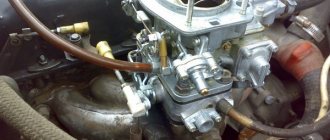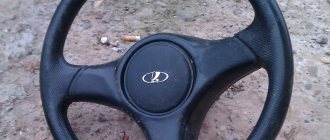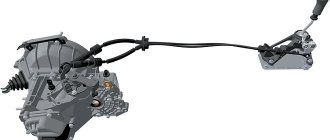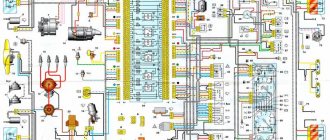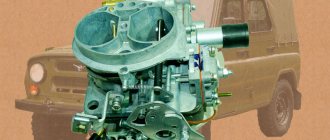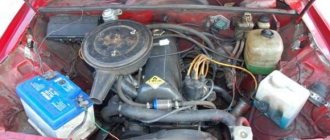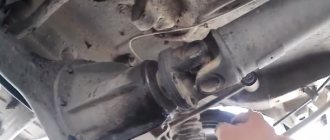Engine performance depends on the quality and quantity of the fuel-air mixture, which is prepared by a special device - a carburetor. The carburetor creates the mixture and distributes it evenly to the cylinders. There are different ways to mix the fuel mixture with the air flow. For example, there are float carburetors and membrane-needle carburetors. Carburetors of the VAZ family, produced by the Dimitrovograd Plant (DAAZ), are classified as the first type - float-type.
Correct adjustment of the VAZ 2107 carburetor is, first of all, about the engine in working condition and fuel economy.
Carburetor Types
Before you begin adjusting the carburetor, determine what type of carburetor is installed on the engine. It's quite easy to do this:
- If there is a vacuum corrector on the ignition, this means that you have the latest type of engine 2106 or VAZ 2103, and a carburetor modification 2107 - 1107010-20.
- If your VAZ 2107 car has a six engine, but no vacuum corrector is installed, then this modification of the carburetor is 2107-1107010-10.
Carburetor components that need to be adjusted:
Before adjusting the carburetor, you need to determine the main signs of its malfunction. Since this engine unit is responsible for the vehicle’s acceleration dynamics and fuel consumption, these include the following:
- difficulty starting the engine, long “shots”;
- sluggish car acceleration;
- all kinds of “jerking”, “jerking”, “failures” when pressing the gas pedal;
- increased gasoline consumption.
So, if your seven has the corresponding signs, you need to start adjusting it.
Attention! It is better to make adjustments with the carburetor removed. When adjusting the VAZ 2107 carburetor, do not use woolen or fleecy fabrics, and do not clean the jets with a wire, just blow them out.
First of all, the float system is adjusted, it’s more convenient.
Types of service
Maintenance of Ozone carburetors can be partial or complete. The first is flushing the unit without removing it from the engine. This is done using special cleaning products such as “Carb Cleaner”. We use the product according to the instructions and continue to operate the car. But the effect of partial maintenance is short-lived and does not always help. Eventually you will have to perform a full service.
Full setup of Ozone carburetors comes down to complete disassembly of the unit, cleaning of the channels, checking the functionality of the mounted units, troubleshooting parts, assembly using spare parts and subsequent adjustment.
Adjusting the fuel level in the float chamber
The free play of the float should be 6.5 mm on one side and 14 on the other. This can be adjusted using a checking template by placing the camera vertically. In this position, the float slightly touches, but does not press on the valve ball.
If the distance does not correspond to the required 6.5 mm, then you need to slightly bend the tongue of the valve (needle-shaped), adjusting the size to the required one, indicated in the figure by the arrow under the letter “A”.
The next step is to adjust the degree of opening of the needle valve through which gasoline enters the float chamber. When the chamber is filled, the float rises and the flow of fuel decreases; when you sharply press the accelerator pedal and open the throttle, the fuel goes into the cylinders, the float drops and gasoline enters the float chamber.
Next, we adjust the deflection of the float in the opposite direction. To do this, move it away from the lid as much as possible and measure it with a template, the thickness of which should be 14 mm with a certain tolerance (Fig. above, picture on the right).
If the distance is greater or less, you need to bend the stop of the float mounting bracket and set it to no more than 14 mm.
Now, after the adjustments have been made, the free play of the float should be within 8 mm. Adjusting the VAZ 2107 carburetor also includes checking fuel filters and incoming screens to maintain a good supply of fuel.
Complex and high-precision device
A carburetor is a complex device consisting of many different components. But the complete device is necessary only for those who professionally configure and adjust these devices.
However, despite all the difficulties and a large number of details, let’s take a closer look at how this device works.
So, what kind of device does the DAAZ 2107 1107010 carburetor have? This device consists of a float chamber into which fuel flows in limited quantities. The access to gasoline is closed by a needle valve, as well as a float, which in appearance resembles a barrel. Gasoline is mixed in a special mixing chamber. The carburetor also consists of a throttle valve as well as an air valve. In addition to them, the device also includes jets. The fuel is atomized through a sprayer. One of the important components of a carburetor is diffusers. They work like nozzles and create an air flow configuration.
Adjusting the starter
When setting up the VAZ 2107 carburetor, you need to adjust the starting device yourself. It is designed to confidently start a cold engine. When properly adjusted, the mixture is twice as saturated with fuel as when normally feeding a hot engine.
The starting device for carburetors from the 1107010 family is triggered at a frequency of 1500 engine revolutions.
A little theory about the starting device
If we look at the carburetor from the side, we can clearly see the channel through which vacuum is supplied to the opener body:
With the carburetor removed, if you look at it from the top, you can see the air vacuum supply channel:
On the disassembled carburetor you can see all the details of this diaphragm starting device:
The picture below schematically shows the starting device of the carburetor of the 1107010 family:
Let's figure out how the trigger mechanism works. By pulling the choke lever, the driver brings the starting device into a cocked state. The following actions occur:
- The three-arm lever is “cocked” with a cable counterclockwise;
- The telescopic rod is activated;
- The rod turns the air damper.
- The second arm of the lever presses on the throttle valve axis of the first chamber.
- The air flow damper closes completely. The throttle valve of the first chamber is slightly open for starting, creating a starting gap
Let's start adjusting the starting device
To adjust the starting device yourself, the first step is to remove the carburetor. Further:
Turn the choke lever to the closed position. In this position the device is turned on.
Now turn the carburetor over and measure the gap between the wall and the edge of the throttle valve (chamber 1). For VAZ 2107 carburetors, this gap is 0.85-0.9 mm. The gap can be measured with a feeler gauge or calibrated wire:
To adjust the gap to this range, you need to bend the drive rod on the throttle valve.
After this, we establish a gap between the channel wall and the edge of the air damper from below (in Fig. 2 below it is designated “A”). To do this, close the damper again, i.e. “cock” the device. Create an imitation of rarefaction of air by recessing the starter rod:
Picture 1
Now the rod has pulled the rod along the slot, and as a result the damper opens. Gap “A” should be 5-5.4 mm.
Figure 2
To adjust this gap, you need to turn the adjustment screw with a screwdriver, but first remove the screw plug from it:
Design Features
The main parts of the carburetor include the exhaust shut-off valve, the burnt fuel assembly outlet compartment, the transition chamber system, the throttle valve, the dosing system, the econostat, the float chamber, as well as the autonomous exhaust system. Each of these nodes performs its own function. We won’t delve deeply into this issue - the knowledge you’ve already gained will be enough to set it up.
- Float chamber.
- Econostat.
- Autonomous idle system.
- Idle clearance valve.
- Throttle valve.
- Dosing system.
- Transitional system of two chambers.
- Crankcase gas removal department.
How to set idle speed
First, make sure that the ignition system is set correctly, all wires are in order and the engine is warmed up to operating temperature.
For this:
- Turn the “mixture quality” screw (counterclockwise) to maximum speed, this will enrich the mixture with fuel;
- Turn the “amount” counterclockwise, while the speed should still increase.
- Perform a quality check to see if you can still increase the speed.
The meaning of this operation is to tighten the “quality” screw with the “quantity” screw unscrewed to 850-900 rpm.
You can determine the revolutions by the tachometer on the dashboard, and if you are skilled, by ear.
Freddy-V8 › Blog › Carburetor adjustment Ozone 2105 and 2107 (modified 07/19/2018)
08/16/2015
Hello everyone!
This post will provide recommendations for setting up the Ozone 2105 and 2107 carburetor for normal operation. The overall success of carburetor tuning lies in the identified serviceability of the associated engine systems. These systems include spark plugs, ignition coil, distributor contacts or hall sensor and switch, phases and clearances in the gas distribution mechanism. The carburetor itself must be technically in good working order. If there is a blockage in the carburetor channels or another factor affecting its proper operation, then it is not recommended to proceed with adjustments. Our tuning example includes a completely washed and blown carburetor, but with incorrect settings of the jets, positions of the adjusting screws and float.
Adjusting the float
Remove the top carburetor cover and place it in a horizontal position with the float up. Measure the gap between the float and the carburetor gasket. The gap should be 4.5 mm. Place the carburetor cover in a horizontal position with the float down.
Measure the gap between the float and the carburetor gasket. The gap should be 12.5 mm. The float stroke should be 8 mm. The distance from the gasket to the bottom edge of the float should not be greater than the depth of the float chamber. The float must not touch the bottom of the float chamber. Adjustment of the float stroke is carried out by its two stops by bending them. Setting the initial position of the throttle valve 1 of the chamber
Screw in the throttle stop screw until the screw begins to touch the throttle stop lever.
After touching the screw, turn the screw 90 degrees clockwise. When tested against light, a thin ring of light should be visible. Setting the initial position of the throttle valve 2.
Screw in the throttle stop screw until the screw begins to touch the throttle stop lever.
After touching the screw, turn the screw 0.5 - 1 degree clockwise so that the screw supports the damper lever, but does not open it. The groove for the screwdriver on the screw must be aligned with the mark on the screw seat. When checking for light, the light ring should not be visible. Adjusting the fuel quantity screw
Adjusting the additional air supply screw
Adjusting the EPHH valve
The EPHH valve must be screwed into the mounting hole until the EPHH nozzle touches the limiter.
This moment can be determined by lubricating the rubber ring with oil and observing the contact of the ring with the mounting hole. The valve must not be overtightened. An overtightened valve may become faulty. Adjusting the carburetor with the engine running
Start the engine.
Adjust the operating speed of the crankshaft using the quantity screw and increase it by 200-400 rpm. Set the position of the throttle valve of the first chamber with the stop screw, by turning the screw 90 degrees counterclockwise, so that the engine does not stall, but runs at a minimum number of revolutions. The groove for the screwdriver on the screw must be aligned with the mark on the screw seat. Adjust the number of revolutions with the quantity screw to 800-850 rpm. Setting the idle speed without instruments
- Use the quantity screw to set the idle speed to 850 rpm.
— Use the quality screw to set the maximum speed to XX. — Use the quantity screw to raise the speed by 100-120 rpm. — Use the quality screw to lower the speed to 850 rpm. By adjusting, you achieve smooth engine operation without shaking or popping in the muffler. Setting the idle speed using the IKS-1 device (instructions for the device)
Start the engine, set the mirror in a position convenient for observation, and use the quantity screw to set the minimum stable engine crankshaft speed. Using a mirror, observe the flame in the cylinder, the color of which depends on the composition of the working mixture. - Slowly turn out the mixture screw until a bright orange flame appears, indicating an overly rich mixture. — Slowly screw in the mixture quality screw until the orange flame disappears and a bright blue flame appears, indicating a normal mixture composition that ensures the best engine performance. — Turn the mixture quality screw another 1/2+1/4 turn and complete the adjustment. To avoid failure of the IKS-1 spark plug, it is forbidden to run the engine at high idle speeds (more than 1200 rpm).
After all the carburetor adjustments, the car should drive without dips or blockages throughout the entire crankshaft speed range, providing maximum power from a healthy engine.
To more accurately adjust the CO level, use the table
09/10/2017
Adjusting the suction damper drive.
07/19/2018
My settings of the OZON-2105 carburetor
All settings are in question, since replacing the UN spout gives a faster access to the maximum speed on the ground. — GTZH 1k — 135. — GVZH 1k — 170. — GTZH 2k — 150. — GVZH 2k — 150. — Spout UN — 5.0. — ZHKH 1k — 6.0. - quantity screw - length 2cm (2 turns). — quality screw — 1 turn (deflection of the screw in any direction reduces the speed). - extra screw air supply - tightened. - float gap - 4.5mm (fuel level above the step). — according to the ICS, fuel combustion is normal (blue flame). — OZ — 8-10 degrees. — spark plug gap — 1mm.
If the carburetor settings provide faster acceleration to 100 km/h, then after that the acceleration drops significantly, almost to zero. If the settings provide stable acceleration after 100 km/h, then acceleration from a standstill turns out to be slower. Apparently, as long as there is no strong air resistance, the fuel burns more efficiently, but with an increase in drag, the fuel burns very poorly, because the carburetor begins to overflow.
Adjusting the air damper drive
If you don't take care of the drive, the car may stall. To do this, you will need a simple Phillips screwdriver and a 7 mm open-end wrench.
The positions of the damper are shown above with the “suction” extended and recessed.
To adjust the drive, do the following:
- drown the “suction”;
- Unscrew the rod fixing screw with a screwdriver (the spring will push it out vertically)
- Tighten the screw;
- Check the valve stroke.
Adjusting the throttle drive
If this drive is incorrectly configured, the car's engine response drops and acceleration dynamics deteriorate. The setup is done with an assistant.
You will need the following tools: a screwdriver, an 8-mm open-end wrench, a flashlight, a ruler or a caliper.
- Turn down the “choke” (air damper drive) completely.
- Have your assistant press the gas pedal all the way to the floor. The throttle valve will open completely, as shown in the picture below, you can shine a flashlight into the first chamber. When you release the pedal, the damper should completely close the first chamber without any gaps. If there are gaps, then proceed to the next step.
- Next, we measure the length of the rod with a caliper; it should be exactly 8 cm. To adjust the length of the rod to the required size, rotate the tips by unscrewing the lock nuts.
After all these operations have been completed, put the rod in place and repeat the check. Nowadays, rods are made of low-quality plastic, which shrinks over time. Therefore, you need to check the operation of the traction after a week or two.
We looked at all the ways to adjust the carburetor yourself. We hope this article helped you, if you have any questions, ask them in the comments and we will definitely answer.
